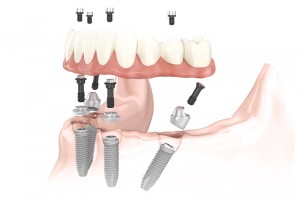Chewing our food is such a basic need and function of daily living, that we don’t usually think much about it…until we can’t do it. Early humans had to eat whatever was readily available to them. Raw meat and root vegetables are easier to chew if you have good teeth, but could mean life or death if you don’t.

Ancient shell, ivory and Mayan jade inlay in an anterior tooth, circa A.D. 900. Jade implants remained intact.
The discovery of fire, cooking with a stick, and later cooking in sea and turtle shells, made chewing easier for our ancestors.
Archeologists have uncovered evidence, going back thousands of years, of humans implanting pieces of shell, ivory and stone in their jaws to replace missing teeth, not just for cosmetic reasons, but for survival.
Dental Implant research was done in the early twentieth century, but it wasn’t until the early 1950s, that Swedish physician and researcher, Per-Ingvar Brånemark, perfected the process of placing a titanium tube into the jaw, to replace the root of the tooth. The titanium implant stimulated surrounding bone to grow around the tube, holding it firmly in place.
Brånemark called this process osseointegration. Although Brånemark successfully placed Dental Implants in the mouth of a very complex patient in 1965, it took almost twenty years for the scientific and medical community to put his research to practical use.
By the 1980s, Dental Implants were usually used to replace single teeth and hold small Dental Bridges in place.
In the 1990s, Dr. Paulo Malo, a dentist who studied and worked in Lisbon, became interested in helping those patients who had few or no teeth and who often had to settle for ill-fitting or uncomfortable dentures.
Malo began to research ways of fastening dentures onto Dental Implants. He was interested in being able to do this without having to use bone grafts to hold the implants in place and to find a solution that would be comfortable and cost effective for his patients.
Because bone is needed in the jaw for successful osseointegration of a Dental Implant, Malo understood that patients who had experienced bone loss through aging or missing teeth, would need bone grafts before implants could be put into place. His research, therefore, focused on placing Dental Implants without having to do bone grafts.
Malo was able to come up with a technique that:

All On Four Dental Implants are comfortable, natural looking, long lasting solution for replacing missing teeth.
- could be done without bone grafting
- used only 4 Dental Implants to secure each arch (top and bottom)
- allowed the patient to have teeth immediately
- saved the patient money, especially the cost of bone grafting
- had a high rate of success
In 1996, Malo successfully placed the first All-on-4s into the mouth of a family member. He still had to do nearly a decade of further research before he could publish his findings and share them with the medical community.
Today, All-on-4s are used to give patients natural looking, high function teeth that last a lifetime.
 About Dr. John C. Stone, DDS
About Dr. John C. Stone, DDS
Dr. Stone teaches dental implant therapy to dentists in two different locations: Atlantic Coast Dental Research Clinic at Palm Beach College and Broward Dental Research Clinic at Broward College. He is a specialist in tooth replacement, a Prosthodontist, and has been placing dental implants surgically since 1975.





